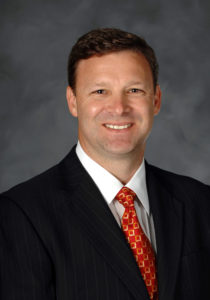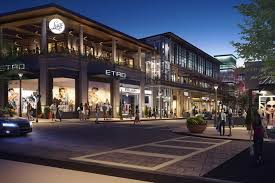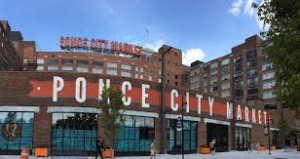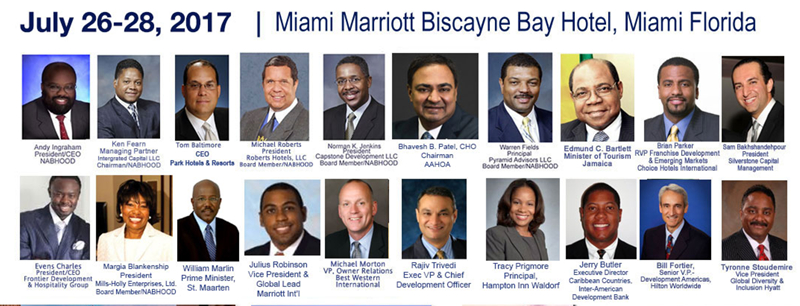How Florida Power & Light is investing in infrastructure to increase efficiency
Eric Silagy President & CEO – Florida Power & Light Company

Eric Silagy in Juno Beach on March 10, 2008.
What have been the most important milestones for Florida Power & Light Company (FPL) in 2016?
This past year, in Miami, we invested more than $50 million in transmission and distribution in the Downtown area. The Miami construction boom has been tremendous, but it has also created a lot of challenges. A lot of planning needs to be done in advance to be able to meet the needs of the new developments. That’s why we try and work really closely with the developers, the city and the county to be able to understand what is going to be happening in the next six to 12 months – and even beyond– so we can anticipate and execute the proper investments in an orderly and efficient way. We have to find the right balance so we can have growth that is done in a way that is the least impactful to residents as possible, but also provides future opportunities for those who live and work in Miami. Another factor that we need to take into account is being prepared for hurricanes. It is very important that we continue to be able to respond quickly because otherwise, the economic damages could be far worse than the physical ones. For example, electric cranes operate PortMiami, meaning they need electricity to operate reliably. If the power goes out due to a storm, the port stops operating, which is why we made important investments to strengthen the infrastructure of the port.
What has been the impact of the smart grid technology in Florida’s electric grid?
We have one of the smartest grid systems in America. Smart grid technology has completely changed the way we see and operate the electric grid. All customers have smart meters, except a small handful that specifically requested not to have them. We have invested a significant amount of resources in technology that now allows us to anticipate possible problems with the grid. The electric grid sends us signals about how it’s operating in real time, showing us what possible failures we could experience so that we can correct them before a problem occurs. We are also using mini-drones to identify certain problems that arise. Once the drone shows us what exactly the problem is, we are able to go in with the correct resources to fix it. This allows us to approach day to day issues proactively instead of reactively, saving a lot of time and money, which helps to keep the electricity bills low. On average, we have been investing in Florida around $3 billion per year over the last six years; in 2016, we invested more than $3.5 billion, and in 2017 we plan to invest more than $5 billion. Yet, in the last 10 years, our bills to customers have gone down 14 percent – primarily because the efficiency gained through technology and process improvements provides greater benefits than the cost to invest in it.
Commentators and analysts are warning e-commerce will spell the death of the shopping mall, but fresh concepts in the retail experience are breathing new life into Atlanta’s brick-and-mortar retail.
Despite worries of a downturn, U.S. retail figures have seen a first quarter boost in 2017. In initial estimates released by the U.S. Department of Commerce in April, the first quarter of 2017 saw overall retail spending at $1.25 trillion, an increase of 5.1 percent on the same quarter the previous year. However, the increase for online retail was almost  three-times that, at 14.7 percent, reaching $105.7 billion.
three-times that, at 14.7 percent, reaching $105.7 billion.
Driven by companies such as e-retailer Amazon, which accounts for 43 percent of all online sales in the U.S., e-commerce has been threatening traditional brick and mortar stores for the best part of the past 20 years. In 2007, e-commerce accounted for 3.1 percent of all retail in the U.S.; as of the first quarter of 2017, this figure stands at 8.5 percent. A CNBC report in May 2016 featured retail analyst Jan Kniffen warning almost a third of all enclosed malls in the U.S. were likely to fail in the near future.
The online sphere offers convenience, choice and often greater value for money. With access to the online world growing year-by-year, it’s easy to think that the days are numbered for the traditional shopping mall.
The rebirth of the mall
Not everybody is convinced by the death toll for the mall though, and “experiential retail” is the buzz phrase driving renewed enthusiasm for brick-and-mortar stores. “We shop online out of convenience, but there is still that experiential factor in, for example, buying a nice suit, and you don’t get that online,” Gene Rice, co-founder of Vantage Realty Partners, an Atlanta-based commercial real estate agency told Focus: Atlanta in April 2017. It is this idea of an “experience” that is emerging as a new direction for brick-and-mortar retail in the U.S. One of the leading examples is Ponce City Market, a 16-acre mixed-use retail, office and residential development in Atlanta, Georgia.
Developed by Jamestown Properties, and situated near the Beltline, Ponce City Market reuses the historic Sears, Roebuck & Co building. “We are working to make retail an attractive substitute to online shopping. We try to make our  environment surprising, challenging and exciting.” Matt Bronfman, CEO of Jamestown Properties told Focus: Atlanta. The idea of combining popular retail stores with other attractions, such as high-end restaurants, leisure pursuits and even live concerts is one taking off across the state.
environment surprising, challenging and exciting.” Matt Bronfman, CEO of Jamestown Properties told Focus: Atlanta. The idea of combining popular retail stores with other attractions, such as high-end restaurants, leisure pursuits and even live concerts is one taking off across the state.
“People are getting more creative with their retail and getting people out of their houses to come shop in store. You start to see barber shops and bars. It’s a different experience,” Rice told Focus: Atlanta.
Central to the success of these developments is combination of other aspects of life, such as work, making the mixed-use development the ideal torchbearer for experiential retail. Avalon, developed by North American Properties, in Alpharetta contains more than 100,000 square feet of office space, along with over 300 planned family housing units in addition to its 365,000 square feet of retail. In addition to cinemas, and high-class restaurants the development also offers yoga lessons and play areas.
“We always need to look at how to attract people to our real estate developments. At Avalon, we have been able to create an urban experience in a suburban setting.” Mark Toro, managing director of North American Properties, managers of the Avalon development, told Capital Analytics.
Both Ponce City Market and Avalon work on the central tenant that people want to enjoy the shopping experience. Indeed, an afternoon shopping can still be an event for either the family who can enjoy quality time snapping up the seasons bargains, or the book-lover that gets lost among the shelves of their favorite store. This is a fact that even companies like Amazon cannot deny as demonstrated by their current program of opening physical stores across the country.
While the internet is surely driving one of the largest shifts in shopping habits since the invention of the shopping mall, it seems that for the moment there is still plenty of life in the bricks and mortar retail store.


 Consumer demand is an important driver of infrastructure development and what MasTec undertakes as a company. Telecommunications is a good example because it is not highly regulated like energy or water, and there is a lot of competition. Municipalities want their residents and businesses to have the best services and best internet speeds, so it is not difficult to get permission to build infrastructure. Local governments are also open as to how they deal with telecommunications companies. This is one of the main areas of infrastructure improvement. While the continued roll out of 4G has been a big driver of growth, there has also been a lot of activity in fiber-to-the-home infrastructure. The desire for increased internet speeds means fiber lines are an important product for us. More and more is being doing over the internet, so consumers are demanding higher speed at home. This is driving our business. Companies such as AT&T have been providing normal internet speeds of up to 50 Mbps. However, in the past year, a new product has come on the market, Gigabit Speed, which is 1,000 Mbps. AT&T already has significant infrastructure in the state because it has provided telephone lines for more than 100 years. Over time it has improved lines, eventually building internet infrastructure which has the main backbone of optical fiber lines, with the lateral, coaxial cables connecting homes and business. The next move is improving this with fiber lines to homes and businesses replacing coaxial cables. A lot of money is spent doing this work in Florida. New fiber infrastructure, called fiber-to-home, provides substantial speed improvements. The same demands are transferring over to the wireless space with mobile technology. This is where 5G will come into play, which is being discussed by all the major telecoms providers. It could be starting as early as 2018. This is a huge driver for our business and the infrastructure sector in general.
Consumer demand is an important driver of infrastructure development and what MasTec undertakes as a company. Telecommunications is a good example because it is not highly regulated like energy or water, and there is a lot of competition. Municipalities want their residents and businesses to have the best services and best internet speeds, so it is not difficult to get permission to build infrastructure. Local governments are also open as to how they deal with telecommunications companies. This is one of the main areas of infrastructure improvement. While the continued roll out of 4G has been a big driver of growth, there has also been a lot of activity in fiber-to-the-home infrastructure. The desire for increased internet speeds means fiber lines are an important product for us. More and more is being doing over the internet, so consumers are demanding higher speed at home. This is driving our business. Companies such as AT&T have been providing normal internet speeds of up to 50 Mbps. However, in the past year, a new product has come on the market, Gigabit Speed, which is 1,000 Mbps. AT&T already has significant infrastructure in the state because it has provided telephone lines for more than 100 years. Over time it has improved lines, eventually building internet infrastructure which has the main backbone of optical fiber lines, with the lateral, coaxial cables connecting homes and business. The next move is improving this with fiber lines to homes and businesses replacing coaxial cables. A lot of money is spent doing this work in Florida. New fiber infrastructure, called fiber-to-home, provides substantial speed improvements. The same demands are transferring over to the wireless space with mobile technology. This is where 5G will come into play, which is being discussed by all the major telecoms providers. It could be starting as early as 2018. This is a huge driver for our business and the infrastructure sector in general.


 experts about new development opportunities in South Florida. This program explores the unique half billion dollar investment opportunity in the emerging Pompano Beach Downtown Innovation District and the plan for an innovative and resilient drainage district!
experts about new development opportunities in South Florida. This program explores the unique half billion dollar investment opportunity in the emerging Pompano Beach Downtown Innovation District and the plan for an innovative and resilient drainage district! three-times that, at 14.7 percent, reaching $105.7 billion.
three-times that, at 14.7 percent, reaching $105.7 billion. environment surprising, challenging and exciting.” Matt Bronfman, CEO of Jamestown Properties told Focus: Atlanta. The idea of combining popular retail stores with other attractions, such as high-end restaurants, leisure pursuits and even live concerts is one taking off across the state.
environment surprising, challenging and exciting.” Matt Bronfman, CEO of Jamestown Properties told Focus: Atlanta. The idea of combining popular retail stores with other attractions, such as high-end restaurants, leisure pursuits and even live concerts is one taking off across the state.